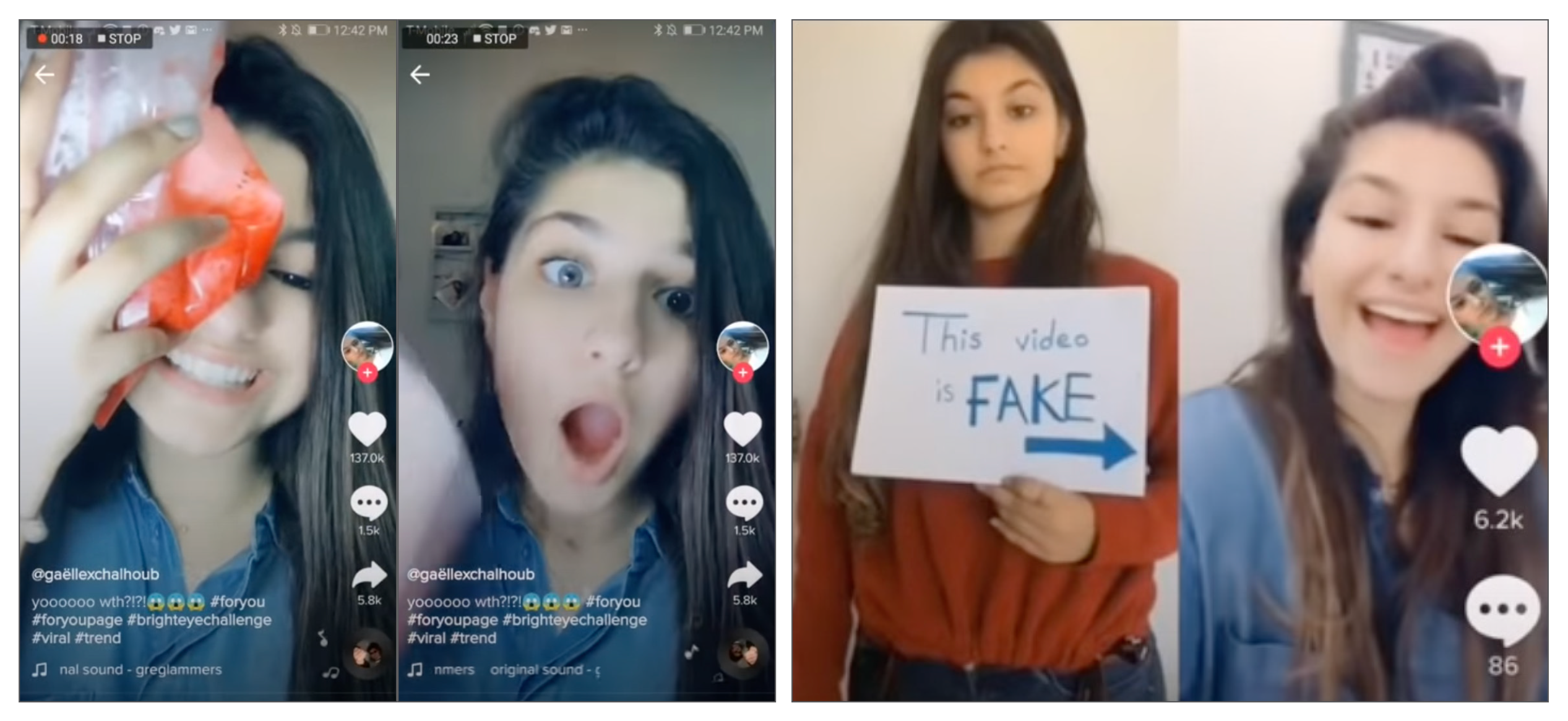 |
| Many online trends can contribute inadvertently to adverse ophthalmic effects. Even when the infamous “bright eye challenge” on TikTok was debunked as a fake, videos remained in circulation and helped create an environment of misinformation. Photo: TikTok. Click image to enlarge. |
The social media platform TikTok has been used to share mostly harmless trends and challenges among its predominantly young audience, but some do pose serious risks to adolescents and teenagers who seek validation and attention from peers. Considering about 41% of the user base falls between the ages of 16 and 24, and a third are 14 or younger, it is important to highlight those trends that do pose potential harm. A recent research paper in the online journal Ophthalmology and Therapy cataloged a variety of reckless and foolhardy activities shared on TikTok that can endanger eye health.
Included in discussion of this new research were the “rubbing castor oil trend,” “bleach/bright eye challenge,” “mucus fishing challenge,” “eggsplosions,” “beezin challenge,” “Orbeez challenge,” “blow-drying eyelashes,” “sun gazing” and “popping styes” TikTok trends/challenges. The number of views, likes and shares was documented for each video of the respective challenge with the highest like count.
The first on the list, rubbing castor oil both onto and inside the eyes, has the purported benefits of decreasing wrinkles and—somehow—improving vision. A few studies do show that castor oil can enhance the lipid component of the tear film and decrease evaporation time, but can be dangerous to employ without medical supervision, due to many over-the-counter versions containing irritating or harmful preservatives. As well, excessive eye rubbing is linked with keratoconus.
Next is the bright eye challenge. This involves putting on the eye a bag filled with jelly, hand sanitizer, bleach and shaving cream to lighten eye color. This can cause irritation and permanent cellular damage due to protein denaturation, a property of bleach. Permanent damage can occur in case of leaks and extravasation into the eyes; this challenge has been removed from the platform, though. This challenge, however, may have begun on TikTok as a prank or parody and largely received as such by users rather than something to be acted upon. It’s also worth noting that the bleach eye challenge dates back to 2019, an eternity ago in the fast-paced world of social media, and TikTok in particular, and thus is likely to be long forgotten by today’s users.
Another challenge noted by the researchers is to force out mucus from an irritated eye using a Q-tip or finger. This can lead to a cycle of “mucus fishing syndrome,” a cyclic condition involving extraction of mucous strands from the eye, and is often triggered by ocular irritation. This leads to more mucous discharge, perpetuating eye irritation and the cycle. Mucus fishing can also cause mechanical conjunctivitis.
“Eggsplosions” happen from hard-boiled eggs being microwaved and then cut into pieces to intentionally burst open. This is a concern when hitting nearby objects, like the eye, leading to direct trauma. Similarly, the “Orbeez challenge” involved paintball guns to shoot gel pellets, also leading to potential ocular trauma. In fact, this challenge has caused 19 serious ocular injuries, as reported in one 2022 review, with 11 out of 19 occurring in those younger than 18. Another indirect cause of harm may occur from a trend that advocated blow-drying one’s eyelashes, since the eyes are not well-suited to endure such forceful air in close proximity. Attempting this could cause dryness, irritation or even long-term consequences of corneal abrasions and infections, which could lead to blindness, especially for contact lens users.
Other documented trends of concern include sun gazing, in which viewers intentionally gaze at the sun for five to 10 seconds, which can lead to solar retinopathy and cause central or paracentral scotomas. “Stye popping” is yet another trend that can harm the eyelid through people using their fingers, needles or tweezers for expression of eyelid lesions. Spread of infection is possible or worsening of the stye, with possible complications of pigmented scars, scar tissue and pitting scars.
All of these videos have millions of views each, the paper notes, highlighting how pervasive these trends can become and harmful if followed uncritically by impressionable young viewers. The study authors warn that “encountering substandard medical information on social media platforms presents significant hazards to patients. It may lead them to make critical medical choices relying on potentially erroneous data. This could result in adverse consequences, such as applying over-the-counter castor oil to treat various medical conditions.” As such, doctors and parents should be vigilant for incorrect and just plain foolish medical content on social media platforms.
Hassan SA, Ghannam AB, Saade JS. An emerging ophthalmology challenge: a narrative review of TikTok trends impacting eye health among children and adolescents. Ophthalmol Ther. February 5, 2024. [Epub ahead of print]. |

